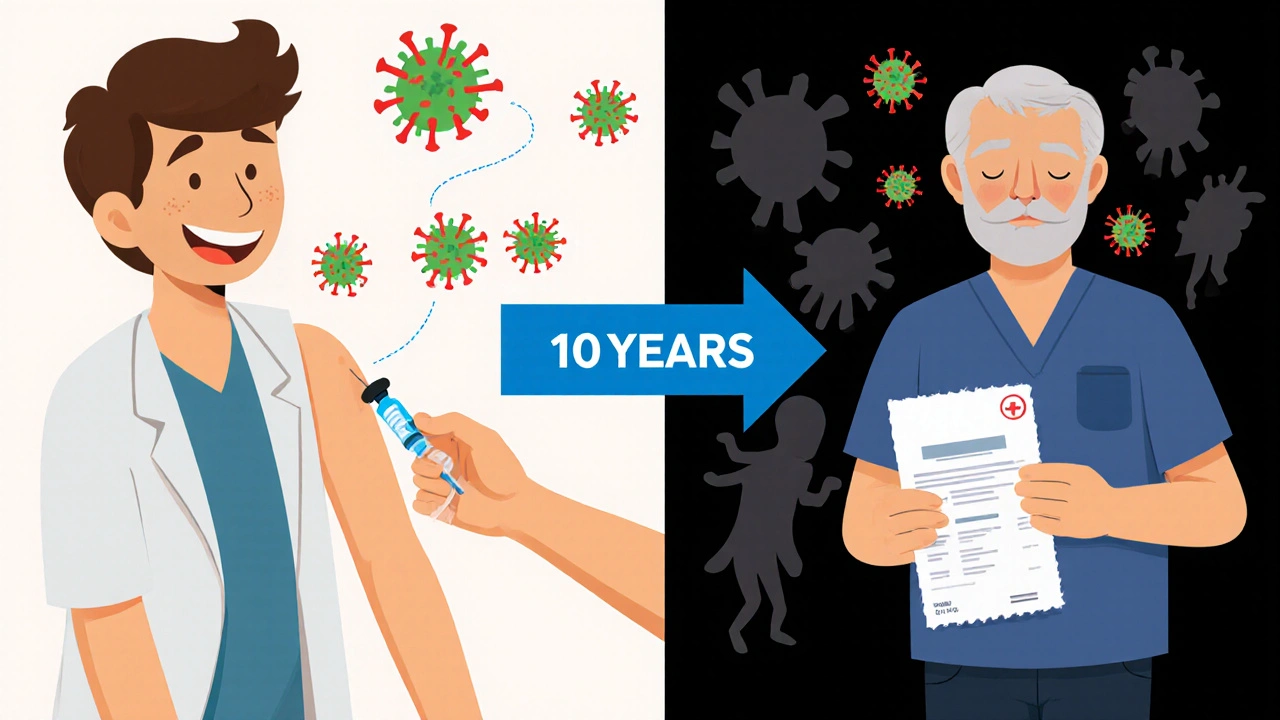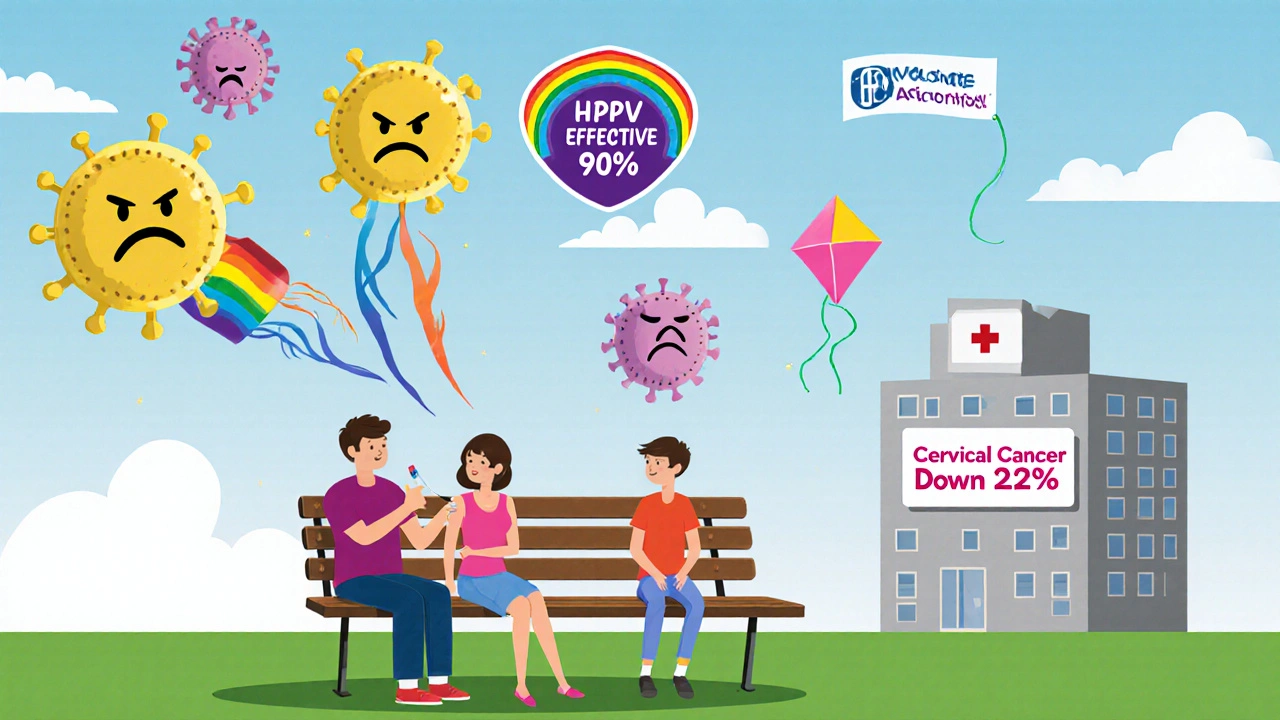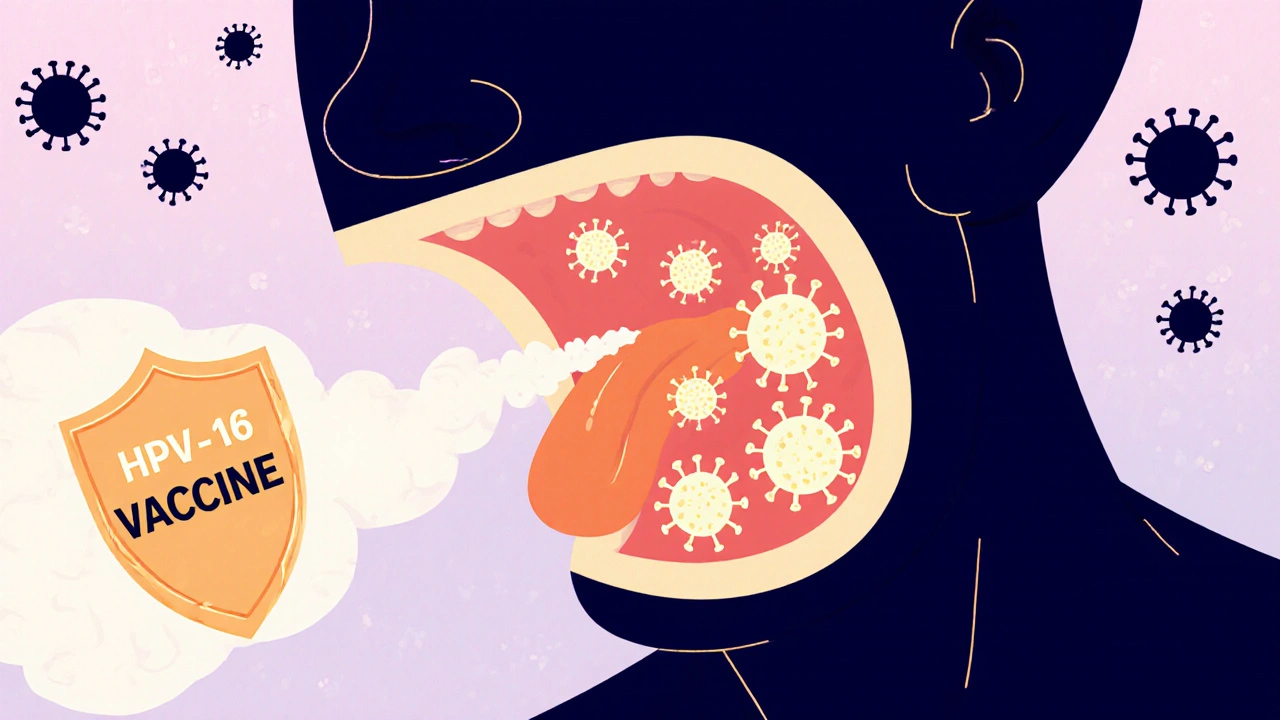Most people don’t realize that a common virus can cause cancer - and not just one kind, but several. Human papillomavirus, or HPV, is behind most throat cancers, nearly all anal cancers, and a large share of cervical, vaginal, vulvar, and penile cancers. In the U.S. alone, HPV causes nearly 48,000 new cancer cases every year. And here’s the twist: HPV-related cancers are among the most preventable cancers we have.
Why HPV Is More Than Just a Sexual Health Issue
HPV isn’t rare. Nearly everyone who’s sexually active will get it at some point. It’s so common that 80% of people will be infected by age 45. Most of the time, the body clears it on its own. But when it doesn’t - especially with high-risk types like HPV 16 and 18 - it can stick around for years, silently changing cells until they turn cancerous. The real danger isn’t the virus itself. It’s what happens when it lingers. HPV 16 alone causes about 85% of throat cancers linked to HPV and 70% of cervical cancers. These aren’t random outcomes. They’re predictable results of persistent infection. And while cervical cancer has been dropping thanks to Pap tests and vaccines, other HPV-related cancers are climbing - especially in men.Throat Cancer: The Fastest-Growing HPV-Linked Cancer
Oropharyngeal cancer - cancer of the back of the throat, including the tonsils and base of the tongue - is now the most common HPV-related cancer in the U.S. More men get it than women. In fact, 80% of all HPV-associated cancers in men are throat cancers. Between 2001 and 2017, the number of these cases rose by 2.7% every year. That’s not a small blip. That’s a steady climb. Why now? Experts point to changes in sexual behavior over the last few decades. Oral sex is more common, and HPV can be passed that way. But the bigger issue? Lack of vaccination. Unlike cervical cancer, there’s no routine screening test for throat cancer. You can’t catch it early with a swab or scan. That means prevention - not detection - is the only real defense. Survivors often face long-term side effects: trouble swallowing, permanent voice changes, needing feeding tubes, and massive medical bills. One man in his 40s told his support group he spent $127,000 out of pocket, even with insurance. That’s not just a health crisis. It’s an economic one.Anal Cancer: Underdiagnosed and Increasing
Anal cancer is another HPV-driven cancer that’s on the rise. About 91% of cases are caused by HPV, mostly type 16. It’s more common in people with weakened immune systems - like those with HIV - but it’s also increasing in the general population. Men who have sex with men have higher rates, but heterosexual men and women are getting it too. Unlike cervical cancer, there’s no widespread screening for anal cancer. Some doctors offer anal Pap tests for high-risk groups, but it’s not standard. That means most cases are found only after symptoms appear - bleeding, pain, lumps, or changes in bowel habits. By then, treatment is harder and more invasive. The good news? The same vaccine that prevents cervical cancer also prevents anal cancer. And the earlier you get it, the better the protection.
The Vaccine That Works - But Isn’t Used Enough
The HPV vaccine, Gardasil-9, protects against nine types of HPV - including the two most dangerous (16 and 18) and seven others that cause most cancers and genital warts. It’s 90% effective at preventing cancers caused by these types. That’s not a guess. That’s what clinical trials and real-world data show. The CDC recommends the vaccine for all kids at age 11 or 12. Two doses, six months apart, are enough if started before age 15. If you’re older, you can still get it up to age 26. For adults 27 to 45, it’s a shared decision with your doctor - especially if you haven’t been exposed to many HPV types yet. But here’s the problem: only 65% of teens in the U.S. are fully vaccinated. That’s not because the vaccine doesn’t work. It’s because parents are scared. They think it encourages early sex. They worry about side effects. But the data says otherwise. The most common side effect? A sore arm. Serious reactions are rarer than being struck by lightning. In Rhode Island, schools started offering the vaccine on-site. Within six years, vaccination rates jumped from 53% to 84%. High-grade cervical lesions - the pre-cancer stage - dropped by 22%. That’s what happens when you remove barriers.Screening: The Other Half of Prevention
For women, the vaccine isn’t the whole story. Screening still matters. The U.S. Preventive Services Task Force now recommends primary HPV testing every five years for women 25 to 65. That’s more accurate than Pap tests alone. If HPV is found, follow-up tests catch changes before they turn cancerous. New tools are making screening easier. Self-sampling kits - where you collect your own vaginal swab at home - are now FDA-approved. In one study, they boosted screening rates by 24%. That’s huge for people who avoid doctors due to embarrassment, cost, or access. But for men? No screening exists. That’s why vaccination is even more critical. If you’re a man, and you’re not vaccinated, you’re not just at risk for cancer - you’re a carrier who can pass HPV to partners.Who’s at Risk? The Numbers Don’t Lie
HPV-related cancers don’t hit everyone equally. Non-Hispanic White men have the highest rates of throat cancer. Non-Hispanic American Indian and Alaska Native women have the highest cervical cancer rates. Asian and Pacific Islander populations have the lowest rates across the board - but that doesn’t mean they’re immune. Age matters too. Most HPV cancers show up between 55 and 70. That’s because it takes years - sometimes decades - for the virus to cause cancer. So if you’re in your 40s or 50s now, the infection you got in your 20s could be turning into cancer today. And stigma? It’s real. Many people feel blamed for getting cancer from a virus they caught during sex. But HPV is like the common cold - it’s everywhere. Most people never know they had it. And having it doesn’t mean you did anything wrong.
The Cost of Waiting
Treating HPV-related cancers is expensive. Cervical cancer costs an average of $142,300. Throat cancer? Nearly $200,000. Anal cancer? Over $135,000. That’s not just insurance claims. It’s lost jobs, missed time with family, and emotional trauma. The vaccine? Two doses cost less than $300 out of pocket - and often nothing at all if you have insurance or qualify for the Vaccines for Children program. Preventing one throat cancer saves over $198,000 in treatment costs. That’s not just smart medicine. It’s smart economics.What You Can Do Right Now
- If you’re under 26: Get the HPV vaccine. Even if you’ve had sex or been infected before, it still protects against types you haven’t seen.
- If you’re 27-45: Talk to your doctor. If you’ve had few partners or haven’t been exposed to many HPV types, the vaccine may still help.
- If you’re a parent: Vaccinate your kids at 11 or 12. Don’t wait. The earlier, the better.
- If you’re a woman 25-65: Get screened with HPV testing every five years. Don’t rely on Pap tests alone.
- If you’re a man: Get vaccinated. You’re not just protecting yourself. You’re protecting your partners.


Comments
Lisa Detanna
My mom got the HPV vaccine for me at 12 and I’m so glad she did. I used to think it was just about cervical cancer, but now I know it’s about throat cancer too - especially for guys. My uncle had it. He’s 52. Lost his voice, couldn’t eat solid food for a year. Vaccine = cheap insurance.
November 23, 2025 at 19:41
Linda Rosie
Agreed. Prevention is cheaper than treatment.
November 24, 2025 at 01:11
Demi-Louise Brown
The data on HPV-related cancer trends is alarming. While cervical cancer rates have declined due to screening and vaccination, oropharyngeal cancers in men have risen steadily over the past two decades. This shift underscores the urgent need for expanded public health messaging that moves beyond gendered assumptions about HPV risk.
November 25, 2025 at 12:32
Javier Rain
My brother got the vaccine at 24. He’s a guy. He didn’t think he needed it. Now he’s telling everyone. I’m getting mine next week. If you’re not vaccinated, you’re playing Russian roulette with your throat. No one talks about this enough.
November 27, 2025 at 12:07
Pramod Kumar
In India, we still treat HPV like a dirty secret - whispered about, never named. But I’ve seen young women avoid Pap smears because they’re ashamed. And men? They think it’s ‘a woman’s problem.’ This post woke me up. We need community health workers to go door-to-door with simple flyers - not medical jargon. Just: ‘This shot stops cancer. For you. For your kids. For your partner.’ Simple. Powerful. No shame.
November 29, 2025 at 06:32
Suzan Wanjiru
I’m a nurse and I’ve seen too many patients come in too late. HPV doesn’t care if you’re religious or conservative or shy. It just waits. The vaccine is free at most clinics if you’re under 26. If you’re older and unsure - talk to your doc. It’s not about sex. It’s about cells turning bad. And we can stop it.
November 30, 2025 at 16:34
Karla Morales
Let’s be real - the anti-vaxxers are the reason this is still a problem 😒. ‘It causes autism’? Bro. The vaccine has been given to 300 million people. The side effects? A sore arm. That’s it. You’re more likely to die from a vending machine falling on you than from the HPV shot. 😑
December 1, 2025 at 23:47
Jennifer Shannon
It’s fascinating - and deeply tragic - how deeply embedded stigma is in our public health responses. We vaccinate children against measles without hesitation, yet when it comes to HPV - a virus transmitted through skin-to-skin contact, often before marriage, often unknowingly - we freeze. We hesitate. We whisper. We delay. We wait. And while we wait, the virus lingers - silent, patient, unrelenting - rewriting DNA in the backs of throats, in the lining of the anus, in the cervix - turning normal cells into ticking time bombs. We treat the body like a moral ledger, as if infection equals failure. But viruses don’t judge. They replicate. And we, as a society, have failed to meet them with science - and instead met them with silence.
December 2, 2025 at 11:07
Henrik Stacke
Interesting how the UK’s uptake remains stubbornly low among teenage boys - despite clear evidence of benefit. The NHS offers it, yet cultural inertia and misinformation persist. I’ve had patients in their 30s ask, ‘Is it too late?’ - and the answer is always: ‘No, but it’s better if it wasn’t.’
December 3, 2025 at 02:49
Manjistha Roy
My cousin was diagnosed with anal cancer at 38. She had no symptoms until it was stage 3. No screening. No warning. She said she didn’t know HPV could cause that. I cried for days. Now I tell every woman I know - and every man too - get the vaccine. It’s not about sex. It’s about biology. And biology doesn’t care about your beliefs.
December 3, 2025 at 21:58
Jennifer Skolney
Just got my second dose at 29! 🙌 I was scared I’d missed the window - but my doctor said even if I’d been exposed, it still protects against other strains. My partner got it too. We’re not ‘promiscuous’ - we’re just smart. 💪❤️
December 4, 2025 at 09:02
JD Mette
I didn’t know men could get HPV-related throat cancer. My dad had it. He’s fine now, but it changed everything. I’m getting the vaccine this month. No more guessing.
December 4, 2025 at 22:20
Olanrewaju Jeph
As a medical professional in Nigeria, I can confirm that awareness remains critically low. Many believe HPV is a myth or a punishment. The vaccine is available in major cities but often underutilized due to misinformation and religious resistance. Community engagement, not just clinical outreach, is essential. The science is clear. The tools exist. What is lacking is the courage to speak plainly.
December 5, 2025 at 14:36